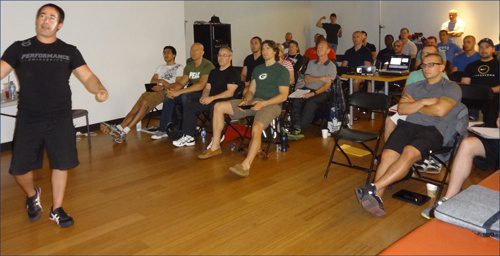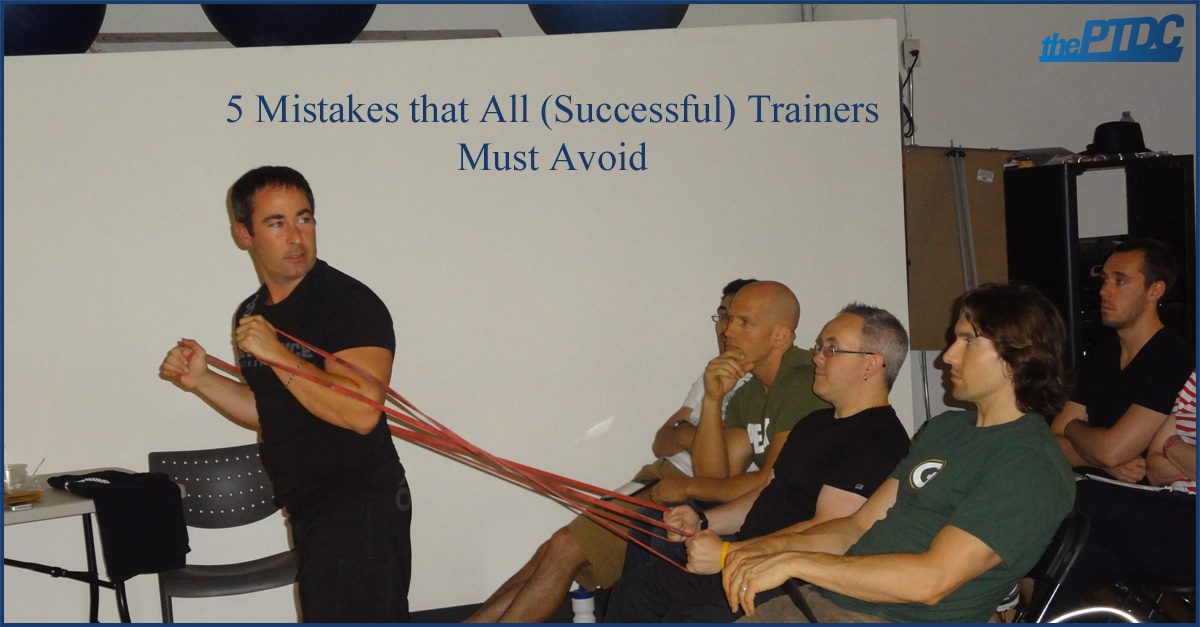Have you ever thought about the decisions you made early in your training career and asked yourself, "What was I thinking?"
It's nothing to get upset about. Just make a conscious effort to improve yourself and you'll come out better for it. Failure is the most effective teacher you can ever have.
Here are five of the biggest mistakes I made when starting personal training.
1. I hopped on trends without thinking it through
When I first started personal training, I immediately noticed that most trainers in my network hated cardio. My Facebook feed consisted of rants about why cardio sucks, blogs about how jogging will make you fat, and other assorted nonsense. Since my idea of "cardio" is to simply lift weights faster like Jen Sinkler, it was easy to hop on this trend and bash it just like everybody else.
This shortsighted decision reflected a complete lack of foresight on my part. Who knows how many potential clients I could have alienated with my derogatory comments about an activity that a whole lot of women (the gender I coach most often) just so happen to enjoy?
While it could be argued that the efficacy of resistance training trumps cardio for fat-loss, it is silly to think the average person would be willing to retire their running shoes for that reason alone.
The Fix: Write a purpose and philosophy statement to stay on track.
If you don't have a firm foundation of principles that guide your decisions, then you might be tempted to follow whatever trend is popular at the moment. Writing a purpose and philosophy statement helped me avoid the temptation of following the crowd without first considering the needs, wants, and desires of the potential clients I hoped to serve.
Ask yourself these key questions and write down your answers to get started:
- What are my greatest personal strengths as a trainer or coach and how can I express them?
- What are some key differentiators that could help me stand out in a crowd of other trainers?
- What benefits (functional, aesthetic, and emotional) do my clients hope to achieve through training?
- What kinds of activities (whether I personally enjoy them or not) do my clients find fun or interesting?
While you probably wouldn't take your client on a run in the middle of a training session, you could suggest how they might pursue this activity in a way that would be most beneficial to their progress.
If your client expresses interest in an activity that you aren't familiar with, you can still give them a gentle shove in the right direction. Surprise them with an email containing a helpful article as Jon suggests in this blog post about building your client army.

Attend smaller events with independent thinkers. Don't blindly follow the herd.
2. I put my selfish beliefs before my clients' individual needs
When I first started personal training, I assumed I knew what was best for my clients. Of course, I performed an assessment to make sure they could do a routine safely. Beyond that, I had a structured plan that I prescribed for just about everybody without stopping to consider if it made sense for their unique situation.
The Fix: Figure out what makes your client tick as soon as you start training them.
If you don't take the time to understand where your client is coming from, then you could find yourself training them in a way that doesn't make sense. Consider these three client profiles:
Mary, a 50 year-old stay-at-home mom, hasn't exercised in a very long time. She isn't confident in her athletic ability and associates movement with misery, because she can't walk up a set of stairs without getting winded.
Ashley, a 21 year-old college student, exercises every now and then. She hasn't been consistent enough to get results, because she gets bored with things very easily.
Tracy, a 35 year-old fitness junkie, exercises constantly. She doesn't understand why she isn't losing weight because she goes to a spin class every day and spends an hour on the treadmill afterward.
Squats are one of the most effective exercises a person can do, but it wouldn't make sense to throw all three of these women under a barbell during their first training session.
Mary might be better served with basic body-weight or dumbbell exercises that help her build confidence.
Ashley might need a mixed bag of challenges including a wide range of tempos, rep schemes, and other exercise variations that help her stay interested in training.
Tracy sounds like she probably needs to take some more time to recover between sessions. Since she seems to enjoy cardio so much, maybe she would enjoy time-based sets where she executes as many repetitions as possible in 30-60 seconds?
Let's take our egos out of the picture and focus on what our clients need (not what we think they need).
3. I suggested my favorite "pet diets" without deliberation
When I first started personal training, I expected my clients to change their eating habits overnight. A few years prior, I lost a lot of weight by following the slow carb diet popularized in "The Four Hour Body" by Tim Ferriss. I was also a fan of intermittent fasting, one of the hottest fitness trends at that time.
Instead of addressing the root causes of my clients' poor eating habits, I suggested one of these approaches, which weren't sustainable for the average person. I often wondered why they couldn't "stay motivated" long enough to achieve their goals. I blamed them for a "lack of compliance" at the time. Now I know the fault was mine alone.
The Fix: Instead of suggesting a specific meal plan, encourage them to explore their individual relationship with food (if done correctly, most problems will take care of themselves).
If you don't consider why your clients eat the way they do, then you can't expect them to change their habits for the better. Sure, they might be able to follow a strict eating regime for a few weeks or months, but what do you think will happen when they stop following that plan?
They will probably end up right back where they started. Restrictive diets do little to educate people about what it takes to sustain a healthy weight. It is better to help them become mindful of the emotional and situational triggers that influence their eating decisions.
Mindful eating might be new to you, so I am including a handout of a reflection exercise that I ask my clients to perform.
4. I pitched myself to whoever happened to cross my path
When I first started personal training, I marketed myself to "people who would like to lose weight and feel confident in their body." This simplistic description did little to differentiate me in a crowded fitness market. That resulted in an awkward situation where I received applications from potential clients who were not a good fit for my service.
The Fix: Determine the demographics of the type of person who would be most interested in (helped by) your service, tailor all marketing materials to them, and forget about the rest.
If you don't know the characteristics of your target market, then you won't have much success attracting the right people to your service. I'm a firm believer in mindful eating, but it's not for everybody.
With that in mind, I now include sentences like this in my sales scripts:
"If you're looking for a trainer who will give you a meal plan that tells you exactly what to eat, then my coaching program isn't a good fit for you."
You might be worried about reducing your pool of potential clients. Don't be. Would you rather:
a) Waste your time with a client who is a terrible fit (and could end up leaving a negative review online or telling all their friends you suck)
- or -
b) Put up a barrier that prevents situations like this from happening?
5. I wasted too much time trying to fix a system that wasn't worth fixing
When I was starting personal training, I launched a group-coaching platform that included an online support community. My intentions were positive. I hoped to help clients save money and stay accountable.
But as the saying goes, "The road to hell is paved with good intentions." This service was a nightmare to manage for several reasons:
People were afraid to open-up publicly.
This problem might not have existed if my lead base was larger. If a bunch of people all began the program at the same time, it could've worked. But I didn't receive a sudden flood of applications. It was more like a slow trickle. With people coming and going at different times, it was difficult for my clients to get to know each other as intended.
Different needs, different goals, different experience levels.
My intention was to target beginner personal training clients with a similar starting point, but I found myself with people who achieved their goals at massively different paces. I had to modify things for each individual so much that they were basically getting private coaching for a fifth the cost.
It wasn't economically feasible.
I focused on group coaching when I started; because I was afraid people wouldn't pay up for private coaching (and I undervalued myself as a consequence). In retrospect, this fear wasn't justified. Yes, it's more difficult to persuade a person to pay a higher fee. But you don't need a mathematician to tell you that it's easier to find one client than five clients.
Would you rather be known as the trainer who provides the cheapest rate, or the trainer who provides the greatest experience?
The Fix: There is nothing wrong with needing a "re-do" in your business.
We are all human and all make mistakes. If you realize your existing system isn't working despite many stressful days of work, then it might be time to consider scrapping it for a new approach. There is nothing less productive than trying to repair a broken system that isn't worth fixing.
Articles Referenced
Building Beginner Workout Plans - Jonathan Goodman
Get Start with Online Personal Training - Jonathan Goodman
Rest-based Personal Training - Jill Coleman
Most Personal Trainers Shouldn't do Assessments - Mike Reinold and Jonathan Goodman
How to Build a Personal Training Clientele - Jonathan Goodman
Is Cardio or Strength Training Better for Fat Loss - Nick Tumminello










